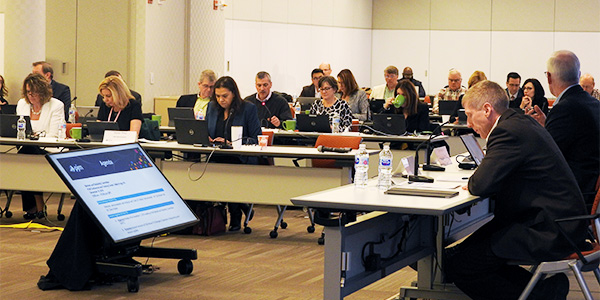By Christen Smith
VALLEY FORGE, Pa. — PJM stakeholders endorsed manual language Thursday that memorializes the Independent Market Monitor’s role in analyzing competitive transmission proposals.
But incumbent transmission owners contend the revisions have no basis in Attachment M of PJM’s Tariff and undermine the yearslong vetting process stakeholders undertook to fine-tune cost-containment language for Manual 14F. (See PJM TOs Wary of Cost Containment Rules.)
Last week, PJM posted manual revisions that added two sentences outlining the Monitor’s ability to access data contained within competitive bids for transmission projects and to perform independent analysis using that information. Incumbent TOs took particular issue with the qualifying clause of the revisions that cite Attachment M of the Tariff as the prevailing source authorizing the Monitor’s involvement in the process.
“Attachment M is silent on what the Market Monitor has access to as it relates to the competitive process,” said Amber Thomas, PPL’s utility regulatory specialist. “Where in the Tariff does it say in Attachment M that the IMM has access to this data? The Attachment M does not say that. To make these big policy changes in Manual 14F to codify something Attachment M does not say does not sit well with PPL.”
The revisions, borne out of a stakeholder motion endorsed by the Markets and Reliability Committee last year, will codify the framework the RTO will use to evaluate competitive transmission projects. (See “PJM Unveils Flat Fee Cost-containment Plan,” PJM PC/TEAC Briefs: Aug. 8, 2019.) Since implementation of FERC Order 1000 in 2014, PJM has reviewed 850 competitive proposals, of which less than 20% included cost-commitment provisions.
Interim CEO Susan Riley clarified Thursday that the revisions represent a compromise about the Monitor’s collaborative role and don’t obligate PJM to share its project analyses, just the data used to support their conclusions.
“The intent is not to have an oversight process over the work that PJM is doing, merely to allow an independent review,” she said. “I don’t think it’s a big give. [The Monitor] does not have approval authority over these projects as to whether they go forward or not. He will just get the data.”
Monitor Joe Bowring said Attachment M, part V “makes clear that the IMM’s access to data is all inclusive.” he added.
“Attachment M is also quite clear and explicit that the IMM has authority to address issues of competition in PJM markets. Competition to build transmission facilities is clearly part of PJM markets,” Bowring added. “These sentences in the manual don’t reflect a compromise; they reflect what our duties are as defined by the Tariff. Under Attachment M, the IMM has the authority to look at competitive issues in the PJM markets.”
The overtures from PJM and the IMM did little to ease incumbent TOs’ concerns. Alex Stern, manager of transmission strategy and policy for Public Service Electric and Gas, questioned PJM’s “procedural gymnastics” in bringing the revisions forward with no opportunity for review or vetting and in defiance of a stakeholder vote overwhelmingly endorsing language that did not include reference to the Monitor.
Stern suggested the MRC instead approve an earlier version of Manual 14F language that excluded the two sentences regarding Attachment M. He said that language was properly vetted by the Planning Committee and through special sessions, as required by the original MRC motion, unlike the revisions PJM and the Monitor crafted and posted online just last week.
He added that expanding the scope of the revisions to include the Monitor’s role was not a part of the discussion until recently — and that it was not driven by stakeholder interest but rather by the Monitor itself. Even so, the recent conversations at the MRC never referenced Attachment M, Stern said.
“The marketplace is not made up by what PJM and the IMM come up with in agreement on their own,” he said. “It’s legally suspect and raises a whole host of questions.”
Bowring called Stern’s accusations “demonstrably false,” pointing to special PC sessions discussing his role in the process and corresponding manual language dating back to August.
“The role of IMM was identified explicitly by a vote of the MRC more than a year ago at the beginning of this process. The specific language about the role of the IMM has been discussed for months in this process,” he said. “In fact, language about the IMM role in the manual was jointly drafted by the IMM and PJM but was removed months ago at the insistence of the TOs.”
Ken Seiler, PJM’s vice president of planning, reiterated the RTO’s interpretation of the Tariff, even if it doesn’t spell out exactly what incumbent TOs say it should.
“As I understand it, there’s language in the Tariff in Attachment M that specifies [the Monitor’s] roles and responsibilities,” he said. “Is it explicit? No. The Tariff is high level. We would try to fulfill those [data] requests based on the spirit of what’s in the Tariff.”
PJM stakeholders overwhelmingly approved the PJM-Monitor language with a sector-weighted vote of 3.92 to 1.08.





